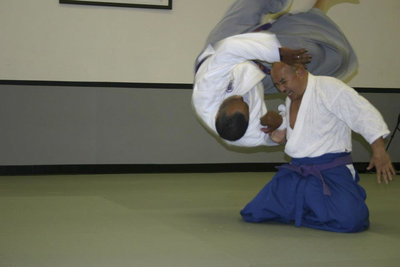“When I first started this, all I wanted to learn was how to punch someone in the face,” said Fred Bernier, co-owner and instructor at Yoshitsune Jujutsu Kai in Bayonne. “But after six months, I started to get something else out of this, something intrinsic, a kind of joy and peace. Anyone can learn out to defend himself within a few months, but after that if they’re not getting something else out of this, they have to question why they are doing it. This is painful sometimes. You really have to love it, and you have to find something in it that is very personal.”
Bernier was talking about the week-long series of seminars featuring Nidai Soke Okuyam, the Current Headmaster of the Hakko Ryu Jujutsu School, and honoring the life and teaching of Hakkoryu Shodai Soke Ryuho, founder the of Hakkoryu style of Jujutsu. But he applies this mentality to all his schooling.
“Our school is the only school on the East Coast that teaches this,” Bernier said. “And this is the first time the headmaster is coming to mainland United States. This is a big deal.”
While the style began with Hakkoryu in Japan shortly after World War II, the martial art, Bernier said, traces its history back to 1100 A.D., and people who get into this usually also get into its philosophy and its history.
“It’s a life style that can be very calming, like Zen, and with practices that are done over and over.”
Yoshitsune Jujutsu Kai is a Japanese Martial Arts School of Jujutsu, Sword and Shiatsu. Training in jujutsu and sword is not a sport and it has no tournaments or competitions. Practice is done with partners who help each other learn and improve, cultivating a supportive environment.
It is very difficult to get ranked in this style, which is why there are so few schools of its kind.
“It takes a lot of time and dedicated to reach new levels,” he said. “These are ancient techniques that are passed down from generation to generation. They rarely change.”
He said there were days when he hits all his points and feels like he is floating.
“There are other days when nothing words,” he said. “But this is no different than a baseball player or a pianist who gets into a groove, something that engages the whole self.”
“It’s a life style that can be very calming, like Zen.” — Fred Bernier
__________
Path of peace in Bayonne
Bernier, a resident of Secaucus for 19 years, was raised in Jersey City, and along with his business partner, Jerry Tardi, a lifelong Bayonne resident, started the Bayonne school in August 2008.
The school gets people from a wide geographical range throughout New York, New Jersey and Hudson County.
“I was always intrigued by martial arts even as a kid,” he said, noting that he grew up watching TV shows such as Gung Fu with David Caradine and a number of Bruce Lee movies. “I just didn’t have the money to pursue it.”
When he got out of the U.S. Army in 1978, he had his funds in order.
For a long time, he taught seminars in places like Secaucus Public Library and other places, dealing with meditation, but he always wanted a school of his own.
Eventually, he took up with Tardi and the school became a reality. The school doesn’t teach young children, just teens and above. Bernier has an agreement with one 67-year-old jujutsu master to teach each other.
“I teach him sword,” Bernier said.
His school is well-known for its sword instruction and will feature an annual visit in October from a master in that art as well.
The jujutsu master, Nidai Soke, will give instruction to senior staff for several days and then on Sept. 15 to 17, he will provide demonstrations to the general public and celebrate the life of his father, the founder of the style.
Bernier doesn’t earn his living off the school. He is a former vice president from McGraw Hill publishers. If anything, he has poured money into his art over the years, following a dream and a vision.
“This is a path you follow, and if you put in the hours of practices, you eventually come to a place of peace,” he said. “It takes a lot of effort and a lot of people do not want to do it.”
